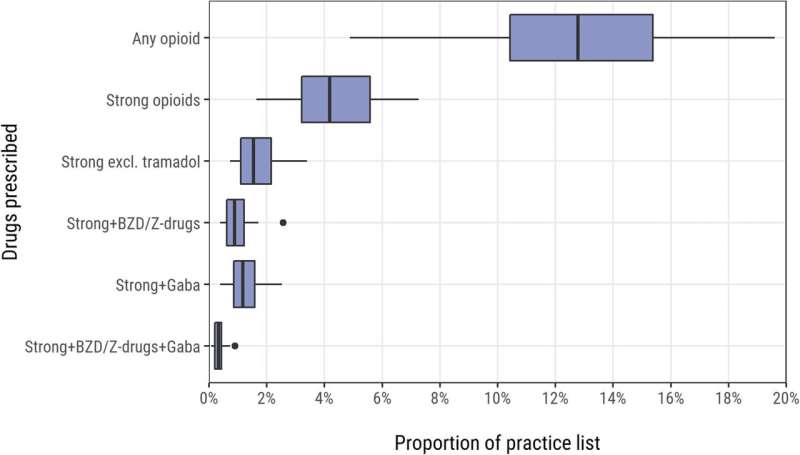Opioids research finds overdose risk factors

New research from the University of Stirling has identified potential major risk factors leading to overdose in patients taking prescription medication.
Working in partnership with NHS Fife, the University of St Andrew's and Glasgow Caledonian University, the Stirling team studied data from GP practices across the Fife region, looking at more than 42,000 patients who had been prescribed opioids over the previous six-month period.
Around one third of patients (14,079) had been prescribed a strong opioid—a range of pain-relieving medication prescribed for acute pain, cancer pain, chronic pain, palliative care or to manage dependence on illicit drugs like heroin.
The research found the most common comorbidities—the presence of two or more diseases in the same person—and overdose risk factors among those prescribed a strong opioid, were pain (67.2%), cardiovascular disease (43.3%), mental health problems (39.3%) and respiratory disease (25.6%).
The number of patients living in the most deprived areas was also found to be significantly associated with the proportion prescribed a strong opioid.

Joe Schofield of the University of Stirling and a researcher on the project, said: "We found those at risk tended to be older, female, and living in areas of high social deprivation.
"There is a need to explore practical interventions to reduce the risk of overdose within this group and clinical practice may need to be tightened to minimize overdose risk for individuals prescribed strong opioids.
"We welcome NHS Fife's commitment to patient safety demonstrated by their funding of this study as part of wider quality improvement work—and we recommend that other Health Boards take a similar approach to reduce the risk of harms to people prescribed opioids across Scotland."
The study was funded by a Research and Development bursary from NHS Fife. Deborah Steven is the lead pharmacist for pain management in Fife and was co-investigator for the project.
She said: "We know that opioids can be useful for some people, but for others can cause issues in the short and long-term. These can include side effects, such as dependency; risk of overdose and, in some circumstances, a worsening of their pain.
"It's vital that these types of medicines are being used safely and effectively and this research has allowed us to better understand current prescribing of opioids to patients locally. Furthermore, the research is also helping individual medical practices to support their patients currently prescribed these medicines, while reducing the risk of accidental harm in patients benefitting from taking opioid medications.
"In the longer term, the research has provided us with a firm, evidence-based grounding to move forward with wider proposals around pain medicines safety here in Fife."
It is hoped the study will impact policy and practice, with researchers advising that risk could be reduced by implementing additional clinical governance such as auditing local prescribing to identify at-risk patients and work with them to review pain management strategies and address potentially harmful combinations of prescribed medication.
Scotland has one of the highest rates of opioid-related overdose mortality in Europe, with the rates of fatal overdose continuing to increase. These overdoses mainly occur among users of illicit opioids such as heroin, however, individuals who are prescribed opioids for clinical reasons can also have increased Prescription Opioid Overdose Risk (POOR). Of the 1264 drug-related deaths in 2019, opioids were implicated in 1,092 (86%) including prescribable opioids such as methadone, buprenorphine, and codeine/dihydrocodeine.
The paper, "Quantifying prescribed high dose opioids in the community and risk of overdose," was published in the journal BMC Public Health.
More information: Joe Schofield et al, Quantifying prescribed high dose opioids in the community and risk of overdose, BMC Public Health (2021). DOI: 10.1186/s12889-021-11162-4


















